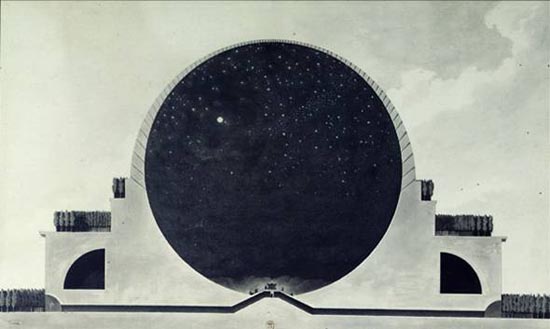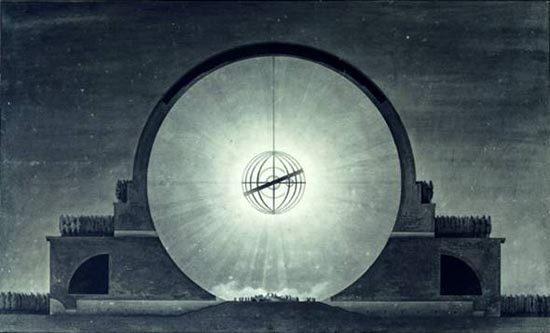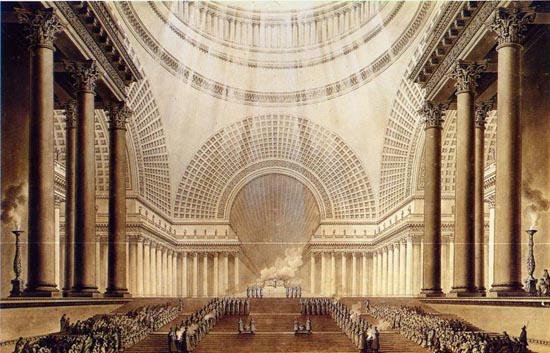ÉTIENNE-LOUIS BOULLÉ, Newton’s Cenotaph, 1780-93
Francisco Martínez Mindeguía
|
|
|
Étienne-Louis Boullée, Newton’s Cenotaph, 1780-93 This is the façade of Newton's cenotaph, possibly Boullée’s most emblematic project. A project that allows us to understand what he meant by saying that the architect should aim at the sublime. A concept that we should not relate exclusively to the greatness. Étienne-Louis Boullée (1728-1799) wanted to be a painter and ended up studying architecture at Jacques-François Blondel’s school, owing to parental pressure. At the age of 19 he became a teacher at the École des Ponts et Chausées, at 34 was admitted as a second class member at the Académie d'Architecture and at 52 as a first class member, until the National Convention abolished the Academy in 1793. He was one of the founders of the Institut National des Sciences et des Arts in 1795. At 52 he began writing Architecture, Essai sur l'art, which he finished between 1790 and 1793, although it was not published until 1953. His book is illustrated with drawings of projects for public buildings he designed between 1778 and 1788: churches, palaces, courts, assemblies, theaters, libraries, museums, city gates, memorial arches, bridges, lighthouses, cemeteries, cenotaphs…After his death, his figure was forgotten, hidden behind the published work of Ledoux and Durand; he was despised by the classics, who saw him as an eccentric seeking to overthrow traditions, and by the moderns who made him responsible for the neoclassical deviations towards historicism and plagiarism. His book contains the key to the understanding of architecture drawing, namely Newton's cenotaph. Blondel said that the building is to find greatness. He particularly said: I tried to apply all the models the nature and art offered me in order to present the image of thegreat(Architecture. Essay on art. GG, pg. 70). Then follows: The picture ofthe great has such sway over our senses that, even if we consider it horrible, it always provokes us a feeling of admiration. A volcano spewing lava and death is a terribly beautiful image! ...Greatness is directly related to beauty and, under different meanings, it is the same whether objects are pleasant or horrifying. Looking grand in anything means revealing superior qualities(Essay, p. 76). It is an argument that matches the concept of the sublime expounded by Edmund Burke. He also said: the image of greatness satisfies us in every aspect because our soul, eager to extend its joys, seems ready to embrace the Universe (Essay. p. 59). Besides from large size, the sublime is achieved by simple forms. He said: Why does the regular shaped figure emphasized at first sight? Because its faces are regular and recurrent and because its form is simple...We distinguish them thanks to the image of order that their regularity and symmetry suggest... The regularity sets the beauty of form; symmetry, order, and overall beauty; variety produces various levels by means of which they are diversified to us ... Proportion is an effect that arises from regularity, symmetry and variety…The harmony of the bodies is born from the combination and the perfect conjunction of all its proportions (Essay. p. 56). Such assessments are those that justify this building’s form. |
 |
|
|
 |
|
From the outside, one can only see half the sphere, supported by two cylinders. Around this sphere, along its perimeter, Boullée places rows of trees. This image recalls Roman tradition in the great mausoleums of Augustus and Hadrian, even though they are different building types, since a mausoleum is a grave and a cenotaph is a monument dedicated to the memory of someone, but inside which no body is preserved. Boullée’s idea coincides with the epitaph written by Alexander Pope in 1732: Nature and the laws of nature were hidden at night. God said, “Let Newton be born!” and all was light. Following the text of his Essai sur l'art : “To produce sad and dark images it is necessary to present architecture by means of a completely bare wall, as I intendedin some funerary buildings, showing a picture of sunkenarchitecture by means of low proportions and buried into the ground; in short, give shape, by means of light absorbing materials, to the dark image of an architecture defined by the shadow effect. This type of shadow-integrated architecture is an artistic discovery that belongs to me ... (Essay, p.71) Boullée and the architecture of shadows. For Boullée, however, this shadow is inseparable from light. In other words, it is a shadow the purpose of which is the sublime perception of light. It is not for a light that shines, but for one that could dazzle, overtake and paralyze. And he applies this concept in public places: museums, libraries, theaters, churches, palaces... One of such buildings is the basilica. |
 |
|
Boullée describes it as the basilica or metropolitan church of Corpus Christi Day, as he says: a house of holiness inhabited by the worthiest ministers of religion. The scenic effect is obvious in the interior perspective drawing: the light at the altar, around the cross, the priest in ecstasy, the faithful ascending the stairs and kneeling in contemplation of the miracle of the Eucharist. Some drawings show a sublime experience. As he says, the objective is to arouse in us a deep worship: this is the goal of religious ceremonies.It is therefore necessary to use all appropriate means to give a character of grandeur and majesty (Essay, p. 62) ...This place ... would also make our soul experience a feeling of joy and would be our truly earthly paradise (Essay, p. 64) ... ... here's what would make this event not only something august/magnificent and exciting, but also truly celestial (Essay, p.64) |
 |
Boullée begins his book by asking “what is architecture?” and denies that it is the art of building, to quote Vitruvius. Architecture is a product of the mind, the fruit of spiritual and intellectual activity and precedes construction. He clarifies that the art of architecture is different from the construction technique. Art is generated by a creative inspiration, while technique is only a mechanical process. He thus confronts the vitruvian approach. But Boullée goes farther: the first issue in architecture is neither technical nor aesthetic, but philosophical and ethical. |
Origin of the images:
All the images are from Étienne-Louis Boullée, Arquitectura, ensayo sobre el arte, Barcelona, Gustavo Gili, 1985
Recommended bibliography:
- Étienne-Louis Boullée, Architecture,
Essai sur l'art, 1793.
The quoted translations correspond to the Gustavo Gili Spanish Editing
- Emil Kaufmann, "Étienne-Louis
Boullée", The Art Bulletin,
vol. 21, nº 3, 1939, pp. 213-227.
- Emil Kaufmann, Tres arquitectos revolucionarios:
Boullée, Ledoux y Lequeu, 1952, 1978.
© of Francisco Martínez Mindeguía’s texts
>> Back to the top of the page
>> Back to Dibujos Ejemplares de Arquitectura
